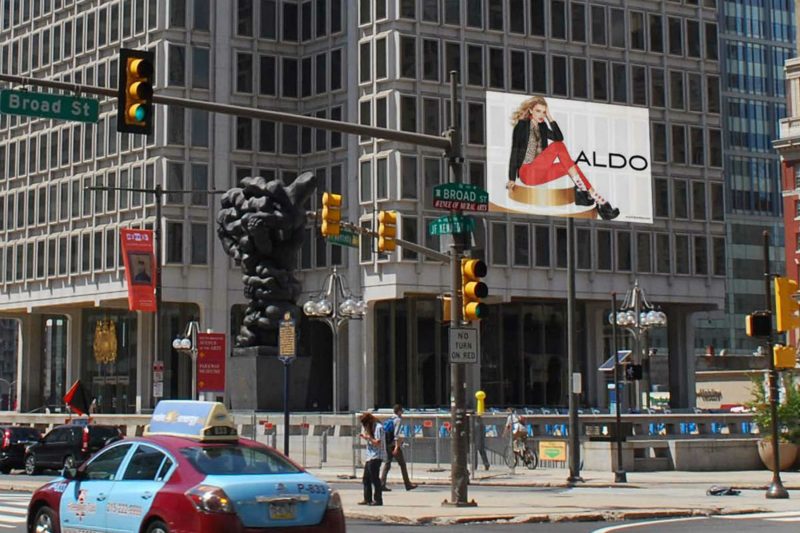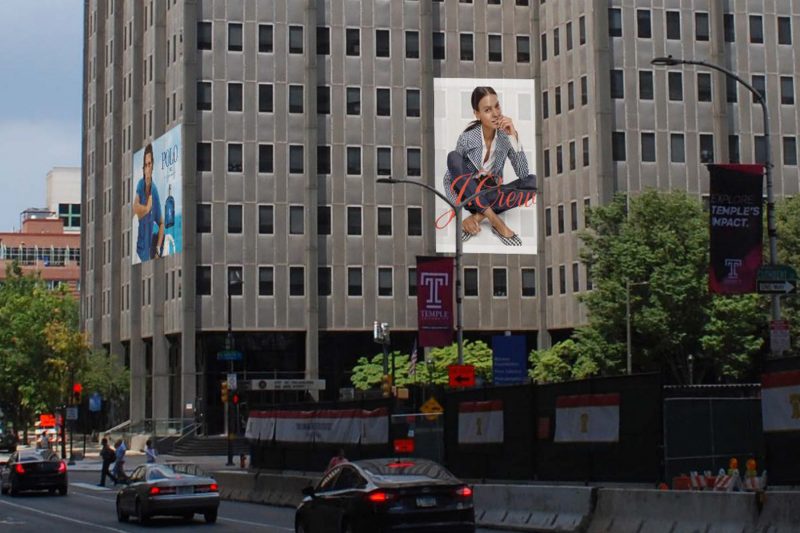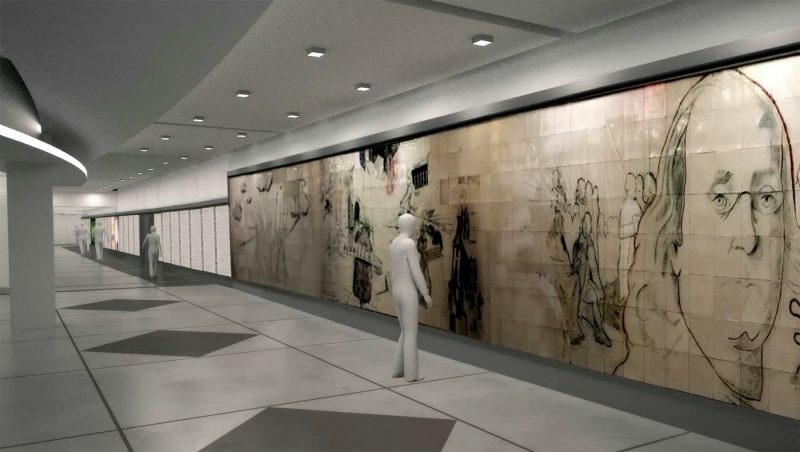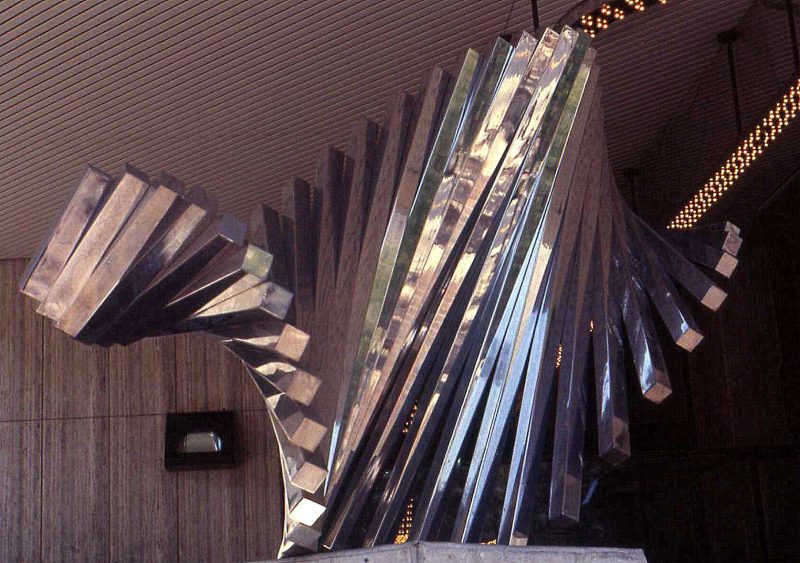
Another month, another billboard. If you feel like you’ve been seeing too many, you’re right. The past year has brought: the Lits Building digital monstrosity at 8th and Market, a new digital billboard at 11th and Vine, and SEPTA’s recently approved Digital Ads at subway stops along the Orange & Blue lines. The Art Commission has been the battleground, seeing two new proposals this month. Luckily this month’s presenter shared a summary of how we got here:
- 2013: the Nutter Administration and City Council passed a law allowing non-accessory* advertisements on all public facilities;
- *In plain English, a “non-accessory” sign is one that’s not related to the building – most commonly an advertisement. An “accessory” sign relates to what’s happening in the building, like a Wawa store having a Wawa sign
- March 2014: The City releases a Request for Proposals for advertisements on any city property or vehicle
- Feb. 2015: Interstate Outdoor Advertising LP is awarded the contract
- Dec. 2015: Negotiations conclude to identify the Municipal Services Building and the One Parkway Building
- Nov. 2016: Interstate Outdoor Advertising LP presents their plans to the Art Commission
This timeline starts with City Council’s 2013 law, opening the door for any City property or vehicle to host an advertisement. This is the vision of Darrell Clarke’s City Council–a city raising sorely needed funds by selling ad space anywhere. Remember that Clarke once proposed a highly unpopular 2013 bill to raise funds for schools through digital ad sales. It’s no surprise that now Council-president Clarke is molding the city to his ad-friendly vision.

Courtesy of INTERSTATE OUTDOOR ADVERTISING LP/TANTALA ASSOCIATES LLC
Interstate Outdoor’s proposal was designed to ruffle the fewest feathers. Their non-digital, non-illuminated billboards, with an invisible frame that nestled into the “building lines” of each property, were designed not to offend. It didn’t work. After every proposal, the Commission invites public comment, and eight people came forward. Local resident Richard Gross called it “an invasion of the the public right to unobstructed views.” Mary Tracy of Scenic Philadelphia recalled being astounded at the news of this proposal, and asked the Art Commission to protect the iconic views of the Parkway. Resident Barbara Chance said these new ads on government buildings would “imply that the city is for sale.” Patrick Grossi of the Preservation Alliance offered some architectural insight. While he conceded that the two buildings are far from beloved, they were designed to promote confidence and strength at a time the city was shrinking. These are mid-century landmarks, argued Grossi, and they deserve to keep their aesthetic integrity.
There were two letters of support: from Mayor Jim Kenney, and Council President Darrell Clarke, who cited this proposal as a great alternative to raising taxes. The Commission was not impressed. Citing traffic studies, PennDOT regulations, and architectural considerations, the Commission was not happy with the design as proposed, but reluctant to stand in the way of progress. While the motion for outright disapproval failed, the Commission moved to disapprove with request for the team to return with new ideas.
Before moving on, Chair Alan Greenberger shared a note of lament. While he acknowledged that the Commission’s role is to review these proposals, he lamented the lack of a clear strategy. These meetings have become the bloody battleground between a City Council that supports billboards, and a public that passionately opposes them. The Art Commission has come to bear this undue responsibility, to rule on each proposal on a case-by-case basis. While Council sees East Market Street becoming the “Times Square of Philadelphia,” the path to get there has been a drip-drip of a leaky faucet, with each new proposal drawing intense criticism. But as long the law supports it, the Commission will continue to be the stage of this fight.
Hate the billboards? Love the transformation?
Write to Council President Darrell Clarke to share your opinion!
OTHER NOTES
Three artworks that were displaced from the Market East Gallery’s reconstruction have found new homes! In addition, Julia Guerrero, Director of the Redevelopment Authority’s Percent for Art Program, shared the news that new firm PREIT will commission new Percent for Art Artworks for the incoming Fashion Outlets of Philadelphia for up to $1 million. More on the relocated artworks:

Image provided by Julia Guerrero
“Philadelphia Now & Then,” by Larry Rivers
Originally underground in the SEPTA Concourse, the mosaic work will find a new home another SEPTA concourse, below the Wanamaker building. It’s an incredible effort, led by Materials Conservation Co, as each of the TK tiles needs to be scraped, and prepared for new installation.

Image courtesy of The Mathematical Tourist, http://mathtourist.blogspot.com
“Amity,” by David Lee Brown
Formerly installed outdoors at 10th and Market, “Amity” will move to the Filbert Street Corridor, between 12th and 11th on Filbert Street.
“Burst of Joy,” by Harold Kimmelman
The most recognizable of the three artworks, located at 9th and Market, will be moved to Central High School where Kimmelman was a student. The piece actually includes the sculpture outdoors, and an additional hundreds of pieces inside the Gallery that will be reinstalled in Central High’s new art wing over the next five years.
The restoration of Rittenhouse’s Billy Goat was not presented today. But Margot Berg, Director of Public Art for the City of Philadelphia, says that they just needed a little more time to coordinate with the Friends Group, and Billy will be back on the agenda soon.









